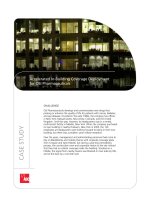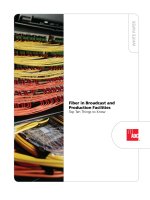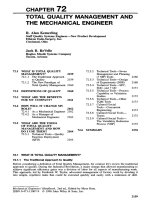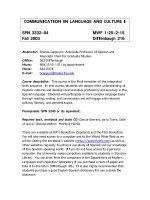Tài liệu Information in use and outsourcing aspects of digital doc
Bạn đang xem bản rút gọn của tài liệu. Xem và tải ngay bản đầy đủ của tài liệu tại đây (579.8 KB, 156 trang )
In memory of my beloved mother Inger,
always near to me
Contact information
Louise Östlund
School of Communication and Design
University of Kalmar
SE-391 82 Kalmar
Sweden
e-mail:
A
BSTRACT
This thesis is founded on the global growth of the service sector and its
significance for society as a whole and for the individual human being. In
the last decade, technology has changed the way services are created,
developed and delivered in remarkable ways. The focus of the thesis is
technology in interplay with humans and organisations and the socio-
economic-technical systems in which digital services play a central role.
Challenges addressed by the thesis include requirement analysis,
trustworthy systems, in- and outsourcing aspects, the proper
understanding of information and its use in real world applications. With
this in mind, the thesis presents a configurable methodology with the
purpose to quality assure service oriented workflows found in socio-
economic-technical systems. Important building blocks for this are
information types and service supported workflows.
Our case study is of a call centre-based business called AKC (Apotekets
kundcentrum). AKC constitutes a part of the Cooperation of Swedish
Pharmacies (Apoteket AB). One of their main services offered to Swedish
citizens is the handling of incoming questions concerning pharmaceutical
issues. We analysed the interactive voice response system at AKC as a
starting point for our investigations and we suggest a more flexible
solution.
We regard a socio-economic-technical system as an information ecology,
which puts the focus on human activities supported by technology.
Within these information ecologies, we have found that a Service
Oriented Architecture (SOA) can provide the flexible support needed in
an environment with a focal point on services. Input from information
ecologies and SOA also enables a structured way of managing in- and
outsourcing issues. We have also found that if we apply SOA together
with our way of modelling a Service Level Agreement (SLA), we can
coordinate high-level requirements and support-system requirements.
A central insight in this work is the importance of regarding a socio-
economic-technical system as an information ecology in combination with
in- and outsourcing issues. This view will prevent a company from being
drained of its core competences and core services in an outsourcing
situation, which is further discussed in the thesis. By using our
combination of SOA and SLA we can also divide service bundles into
separate services and apply economic aspects to them. This enables us to
analyse which services that are profitable while at the same time meet
important requirements in information quality.
As a result, we propose a set of guidelines which represent our approach
towards developing quality assured systems. We also present two main
types of validation for service oriented workflows: validation of
requirement engineering and validation of business processes.
I
P
REFACE
Life is strange and unpredictable, and the last two years of my life have
been evidence of this. In 2005, I felt unrestrained joy and happiness when
my husband Martin and I got married. Two weeks after our wedding, I
was overwhelmed with sorrow when my beloved mother passed away and
a few months later, my aunt also passed away. You see, diseases are
inconsiderate – they have no regard for weddings or future plans, theses
or dissertations. They are just there even if our greatest desire is to cure
them.
One way for me to deal with all this has been to work on this thesis, but
the thesis would not have been completed without the constant support
from my colleague Patrik. He helped me get through the difficult days and
has always been willing to talk and listen whenever needed. Patrik, you
know I will be the first to visit your gas station. Furthermore, I have
always received great support from my supervisor Professor Rune
Gustavsson, from my co-supervisor Päivi Jokela, from all the members of
SoC at Blekinge Institute of Technology and from my colleagues at the
University of Kalmar. I also want to give special thanks to Lars Malmborg
for his continuous support and belief in Patrik and me. Thanks finally to
those involved at Apoteket and AKC, and to our language expert Johan
Höglund for valuable comments.
To my loving family and to my wonderful friends: thank you. Thank you
for always being there for me and believing in me. Finally, to my husband
Martin: your support is beyond words. I would never have managed to
deal with the events of the last few years without you. You make me the
happiest woman on earth.
Carpe diem.
Louise
TABLE OF CONTENTS
III
T
ABLE OF CONTENTS
PREFACE I
TABLE OF CONTENTS III
CHAPTER 1 INTRODUCTION 1
1.1
S
ETTING THE SCENE
1
1.2
T
HE PURPOSE OF THE THESIS
2
1.3
O
VERVIEW OF THE THESIS
2
1.4
R
ESULTS
5
1.5
O
WN CONTRIBUTIONS
5
1.6
A
SSESSMENT OF THE
L
ICENTIATE
T
HESIS
8
1.7
T
HESIS STRUCTURE
8
1.8
G
UIDELINES TO THE READER
9
CHAPTER 2 BACKGROUND 11
2.1
I
NPUT AND FINDINGS FROM THE
L
ICENTIATE THESIS
11
2.2
S
UMMARY OF CHAPTER
13
CHAPTER 3 CASE STUDY 15
3.1
B
ACKGROUND
15
3.2
T
HE VIRTUAL ORGANISATION FOR
AKC 17
3.2.1
A
GENTS
18
3.2.2
G
OVERNING AND CONTROLLING AUTHORITIES AND AGENCIES
19
3.2.3
O
WNER STRUCTURE
20
3.3
L
EGAL FRAMEWORK
20
3.4
P
RESENT STRUCTURE OF
AKC’
S INTERACTIVE VOICE RESPONSE
22
3.5
A
NALYSIS OF ERROR REPORTS
25
3.6
T
OWARDS A CONFIGURABLE METHODOLOGY
27
3.6.1
O
WN CONTRIBUTIONS TOWARDS AN ASSURED WORKFLOW AT
AKC 28
3.7
C
HALLENGES
34
3.8
S
UMMARY OF CHAPTER
37
TABLE OF CONTENTS
IV
CHAPTER 4 SERVICES AND SERVICE DEVELOPMENT 39
4.1
I
NTRODUCTION
39
4.2
T
HE CHANGE OF THE SERVICE CONCEPT
40
4.3
S
ERVICE DEVELOPMENT IN
A
POTEKET
’
S CONTEXT
41
4.4
Q
UALITY ASPECTS OF THE SERVICE CONTEXT
45
4.5
C
ONNECTION TO THE REMAINING PART OF THE THESIS
47
4.6
S
UMMARY OF CHAPTER
49
CHAPTER 5 THEORETICAL ASPECTS OF INFORMATION
AND COMMUNICATION 51
5.1
I
NTRODUCTION
51
5.2
R
EPRESENTATION
,
INFORMATION AND KNOWLEDGE
52
5.3
S
ITUATIONS
,
TYPES AND INFORMATION EXCHANGES
54
5.3.1
S
ITUATIONS AND TYPES
54
5.3.2
E
XCHANGING INFORMATION
57
5.4
S
EMANTICS
58
5.5
I
NFORMATION FLOWS
,
SITUATIONS AND TYPES AT
AKC 59
5.6
I
NFORMATION AND INFORMATION SECURITY
61
5.7
I
NFORMATION QUALITY AND INFORMATION ASSURANCE AT
AKC 64
5.8
I
NFORMATION ECOLOGIES
65
5.8.1
W
HAT CHARACTERIZES AN INFORMATION ECOLOGY
? 66
5.9
AKC
VIEWED AS AN INFORMATION ECOLOGY
69
5.10
S
UMMARY OF CHAPTER
72
CHAPTER 6 METHODOLOGICAL ISSUES 73
6.1
I
NTRODUCTION
73
6.2
M
ODELLING PROCESS
75
6.2.1
C
ONTEXT LEVEL
76
6.2.2
C
ONCEPT LEVEL
77
6.2.3
A
RTEFACT LEVEL
80
6.3
S
UMMARY OF CHAPTER
82
CHAPTER 7 OUR APPROACH 83
7.1
C
HALLENGES REVISITED
83
7.2
I
DENTIFICATION OF WORKFLOWS AT
AKC 85
TABLE OF CONTENTS
V
7.3
I
DENTIFICATION OF TASKS AT
AKC 90
7.4
I
DENTIFYING INFORMATION TYPES
,
FLOWS AND DIALOGUES AT
AKC 90
7.5
E
NSURING INFORMATION QUALITY AT
AKC 97
7.6
A
SET OF GUIDELINES
99
7.7
S
UMMARY OF CHAPTER
100
CHAPTER 8 MODELS OF VALIDATION AND
CONCLUSIONS 101
8.1
I
NTRODUCTION
101
8.2
M
AIN TYPES OF VALIDATION FOR SERVICE
-
ORIENTED WORKFLOWS
102
8.2.1
V
ALIDATION OF REQUIREMENT ENGINEERING
103
8.2.2
V
ALIDATION OF BUSINESS PROCESSES
106
8.3
O
THER VALIDATION ASPECTS
108
8.4
C
ONCLUSIONS
109
8.5
S
UMMARY OF CHAPTER
111
CHAPTER 9 FUTURE WORK 113
9.1
T
HOUGHTS ON FUTURE WORK
113
GLOSSARY 117
REFERENCES 121
F
IGURES
F
IGURE
1.1
G
ENERIC ARCHITECTURE FOR SOCIO
-
ECONOMIC
-
TECHNICAL SYSTEMS
. 3
F
IGURE
3.1
T
HE VIRTUAL ORGANISATION OF
AKC. 18
F
IGURE
3.2
T
REE
-
STRUCTURE FOR THE INTERACTIVE VOICE RESPONSE
-
BASED
WORKFLOW
. 24
F
IGURE
3.3
D
IFFERENT ASPECTS AND ISSUES CONCERNING SOCIO
-
ECONOMIC
-
TECHNICAL SYSTEMS
. 29
F
IGURE
3.4
P
ERSPECTIVES ON A SOCIO
-
ECONOMIC
-
TECHNICAL SYSTEM
. 36
F
IGURE
4.1
W
EB
S
ERVICE COMPONENTS
[41]. 45
F
IGURE
4.2
W
HERE THE DIFFERENT METHODOLOGIES AND THEORIES ARE USED IN
THIS WORK
. 48
F
IGURE
5.1
T
YPES AND INFORMATION FLOWS
[4]. 56
F
IGURE
5.2
A
CONVERSATION DIAGRAM
[4]. 57
F
IGURE
5.3
A
MESSAGE EXCHANGE WITHOUT COMMON GROUND
. 63
F
IGURE
6.1
R
EVISED
C
OMMON
KADS
MODEL
. 75
F
IGURE
6.2
M
ODIFIED TASK MODEL
(
TO THE RIGHT
)
IN RELATION TO THE SOCIO
-
ECONOMIC
-
TECHNICAL SYSTEM
(
TO THE LEFT
). 76
TABLE OF CONTENTS
VI
F
IGURE
6.3
O
VERVIEW OF THE COORDINATION MODEL WITH
SLA 78
F
IGURE
6.4
O
VERVIEW OF THE COMMUNICATION MODEL
[5]. 79
F
IGURE
6.5
G
ENERAL LAYOUT OF A DIALOGUE DIAGRAM
[5]. 80
F
IGURE
6.6
SOA
AS A SUPPORT FOR CUSTOMER ORIENTED WORKFLOWS
81
F
IGURE
7.1
C
HALLENGES FOUND IN SOCIO
-
ECONOMIC
-
TECHNICAL SYSTEMS
. 85
F
IGURE
7.2
D
IVISION OF
AKC’
S BUSINESS PROCESSES INTO SMALLER ELEMENTS
. 86
F
IGURE
7.3
A
NORMATIVE WORKFLOW
. 87
F
IGURE
7.4
T
HE ACTUAL WORKFLOW AT
AKC. 88
F
IGURE
7.5
F
ROM WORKFLOW TO SUBTASK
. 90
F
IGURE
7.6
T
YPES AND INFORMATION FLOW
[4]. 92
F
IGURE
7.7
C
RITICAL HAND
-
OVER SITUATIONS IN THE OVERALL WORKFLOW
. 93
F
IGURE
7.8
A
DIALOGUE SITUATION EXTRACTED FROM THE OVERALL WORKFLOW
. 94
F
IGURE
7.9
S
ERIAL DIALOGUES
. 94
F
IGURE
7.10
A
CONVERSATION DIAGRAM FOR
AKC. 96
F
IGURE
8.1
A
RCHITECTURE FOR VALIDATION EXPERIMENTS
. 102
F
IGURE
8.2
R
EVISED
C
OMMON
KADS
MODEL
. 103
F
IGURE
8.3
W
ORKFLOW GENERATED SERVICES
. 107
T
ABLES
T
ABLE
1.1
O
WN CONTRIBUTIONS
. 6
T
ABLE
1.2
R
ELEVANCE FOR THE DISSERTATION WORK
. 7
INTRODUCTION
1
C
HAPTER
1 I
NTRODUCTION
In this chapter, we introduce the background to this thesis by presenting our work in a
larger context, namely the remarkable global growth of the service sector. Based on this,
we discuss the purpose of the thesis, the relevance of socio-economic-technical systems and
our areas of interest respectively. The achieved results are presented as well as individual
contributions and assessment of our previous Licentiate thesis. The chapter concludes
with a structure of the thesis and some guidelines to the reader.
1.1 Setting the scene
In the opening sentences of the Seventh Framework Programme for
2007-2013 by the European Commission, one can read that Europe faces
an urgent need to reshape its economy and society to be able to meet the
challenges of the 21
st
Century. This fact is based on the globalisation of
markets and the ever faster pace of technological change. Furthermore,
we also have to modernise public services and tackle emerging challenges
within different areas, e.g. the health sector [1]. Globalisation, the
increasing automation, the growth of the Internet and the dynamic
componentisation of business are driving the reconfiguration of service
value networks at a scale and pace never seen before in history. The
opportunity for innovation, research, development, realisation of business
and societal value and delivery of new information and business services
has never been greater [2].
This not only holds for the term “service” that today is most commonly
associated with Web services or Service-Oriented Architectures, (SOA);
there has been a remarkable growth in the service sector as a whole since
it has dominated the economic activity for the last 50 years [2]. Our
society today is increasingly built upon digital services and soon we will
fully enter a digital service society where these services will play a central
INTRODUCTION
2
role in our daily lives. When this happens, they will be a natural and
important part of the socio-economic-technical context in which people
and machines co-operate.
This development of the service sector and the challenges that Europe
faces is behind our interest in digital services, the main topic of this thesis.
We argue that one of the overall purposes of digital services is to mediate
information, which makes information a fundamental part in this context.
Hence the title “Information in use”. With this title as a starting point we
then chose to focus on two different aspects which we think are of great
importance, namely aspects of information quality in workflows where
digital services are a vital part and also in- and outsourcing aspects of
digital services. In this thesis we have used a customer care centre
(Apotekets Kundcentrum which from now on will be referred to as AKC)
which is part of the Corporation of Swedish Pharmacies (Apoteket AB
which from now on will be referred to as Apoteket) as a case study.
Apoteket is the sole retailer of pharmaceutical products in Sweden. Today,
some of the services at AKC are digital and the ratio of these are
increasing within the organisation. However, the results presented are also
valid for other types of businesses that use digital services in their daily
work. The results of the research are based upon the same core, but are
presented in two different theses written by Patrik Brandt (Information in
use: aspects of information quality in workflows) [3] and Louise Östlund
(Information in use: in- and outsourcing aspects of digital services) respectively. The
results from these theses are closely related and can be seen as one unit,
but can also be read individually or as a complement to each other.
1.2 The purpose of the thesis
The overall purpose of this thesis is to find ways to assure the quality of
the information flow between a customer and a human agent at, for
example, AKC. Assuring the information flow in a situation where the
customer or AKC’s personnel interact with digital services is also of
interest. Beside the overall purpose, Louise Östlund’s thesis deals with in-
and outsourcing aspects of digital services and Patrik Brandt’s thesis
exemplifies how information quality can be achieved in workflows where
digital services play a central part.
1.3 Overview of the thesis
As mentioned before, services are central to this thesis. These services in
turn support work- and information flows and it is of great importance
that these are quality assured, especially in a context like the one at AKC
INTRODUCTION
3
since they deal with and mediate pharmaceutical information. In order to
manage requirement elicitation and requirement engineering that support
identification of workflows and services, we have used a configuration of
different tools, methodologies and theories. Figure 1.1 illustrates how
these are involved in our work, and it also shows how the methodologies
and theories have been used and how they are connected. More thorough
descriptions of the components that are shown in the figure are given in
the forthcoming Chapter 4 Services and service development, Chapter 5
Theoretical aspects of information and communication, Chapter 6 Methodological
issues and Chapter 8 Models of validation and conclusions respectively.
Figure 1.1 Generic architecture for socio-economic-technical systems.
Figure 1.1 illustrates our socio-economic-technical system. In the upper
part we find the workplace consisting of people (e.g. customers,
employees) together with an idealised, normative workflow in an
organisation. The workflow is realised when a number of tasks are carried
out; some of these by humans and others by machines. We have drawn a
line around the people and the workflow that shows that this is a part of
the organisational context in which they work, i.e. the workplace. This
workplace is also our object of study, and it is supported by and closely
related to an underlying technical structure. In our effort to understand
the workplace, we are helped by different theories and methodologies. We
CommonKADS
Support-system
requirements
High-level
requirements
Support
Ethnographical aspects
Infosense aspects
Service Oriented
Architecture
Information Ecologies
Service Level Agreement
Service
bundle
Other aspects
Workplace
Workflows
CustomersCustomers
INTRODUCTION
4
have chosen to focus on the Infosense theory [4], the CommonKADS
methodology [5] and also ethnographical aspects to a certain extent. We
are aware of the fact that other relevant aspects exist, e.g. economic,
human behaviour, human computer interaction and so on, but we have
chosen the ones that are relevant to the purpose of the thesis. Another
reason not to add more aspects than the ones we have outlined is that we
need to minimize the aspects considering the complexity in socio-
economic-technical systems. However, we will to return to economic
aspects related to in- and outsourcing of services in Chapter 8 Models of
validation and conclusions.
To be able to analyse a complex socio-economic-technical system, we
need to consider the sociological and the technical aspects of this system
because they are closely related and interwoven. For instance, the
requirements for support that people have in order to perform different
tasks in the workflow, must match the possibilities the underlying
technical infrastructure can offer. Accordingly, there are a number of
requirements that must be fulfilled to achieve a well-functioning
workflow. We have divided these into high-level and support-system
requirements. These concepts are well-known within the area of software
engineering, but are in those situations influenced by technical aspects and
are often restricted to requirements that are directly measurable. In socio-
economic-technical systems however, we see that very crucial trust-related
requirements come from the part of the figure above the dotted line, a
section we refer to as information ecologies since these requirements act
as support in the process of performing tasks correctly. The part of the
figure below the dotted line must then complete certain technical
functions to fulfil the support-system requirements, and some technical
functions are furthermore a part of the support-system requirements.
In our case, the technical part of the system is based upon an SOA. The
high-level and support- system requirements meet in a Service Level
Agreement, (SLA), which acts as an interface between the sociological and
the technical part of the system. The SLA is derived from
CommonKADS meta models and it collects different kinds of services to
something we call a service bundle, that supports and coordinates the
workflow.
In this thesis, I have chosen to focus particularly on in- and outsourcing
aspects of digital services in these socio-economic-technical systems.
These aspects are often discussed in connection with the concept of
INTRODUCTION
5
support-system services and I believe that they are often treated too
lightly. Many organisations bring this into play citing how others have
saved lots of money and increased their efficiency at the same time. This
is true for some organisations but not for all, there is no one-size-fits-all
when it comes to in- and outsourcing. In my view, all of this has to do
with the type of business and the information the business is built upon.
Locating and defining an organisation’s information ecology, in which
core business and high-level requirements exist, will be of utmost
importance when discussing whether to outsource certain services or not.
This also holds for the decision to insource; which services can be
incorporated into existing information ecologies? How can these ecologies
be encouraged to evolve without disturbing the ecological invariants?
Thus, the greatest challenge is to achieve resilient information ecologies so
that a business can be profitable and continue to deliver digital services
without letting go of its core business and appurtenant information.
Solutions to this are briefly described in Section 1.4 Results.
1.4 Results
A result of this thesis is the compilation of a number of key
methodologies that can be configured to analyse workflows and socio-
economic-technical systems. Another result, arising as a consequence of
compiling key methodologies, is the development of guidelines which
serve to first identify fundamental information types within workflows
and then identifying necessary service types to support these workflows.
The service types can then be bundled together to specific service
bundles, which then can be analysed and executed with respect to
performance, to other support-system requirements and also to high-level
requirements. In this way, we have met the challenge to create a reusable
way of analysing workflows and socio-economic-technical systems.
1.5 Own contributions
While working on this thesis, we wrote papers and gave conference
contributions to address different issues related to the AKC context. A
Licentiate thesis has also been written around the same theme. Our
contributions are listed in Table 1.1.
INTRODUCTION
6
Table 1.1 Own contributions.
Nr. Title Authors Way of presentation
1. Communication – a
comparative study of
Langefors, Shannon &
Weaver
Brandt, P. &
Wennberg, L.
(2002)
Systems Science – A
Theoretical Approach.
ISSN 1651-0275
ISBN 91-974341-2-4
2. Risk Analysis in Contact
Centres
Brandt, P.,
Révay, P. &
Wennberg, L.
(2003)
The 4th International
Conference of PhD
Students, Hungary.
3. The importance of
analysing communication
channels from an
information security
perspective – a case study
Wennberg, L.,
Brandt, P. &
Révay, P. (2004)
MicroCAD 2004,
International Scientific
Conference, Hungary.
4. System Thinking in Risk
Analysis
Brandt, P.,
Révay, P. &
Wennberg, L.
(2004)
The Forty-Eight Meeting
of the International Society
for the System Science,
USA.
5. Informatisk forskning om
riskanalysprocess
applicerad på Apoteket
AB:s
kundcenterverksamhet
Brandt, P. &
Wennberg, L.
(2004)
Licentiate Thesis, Blekinge
Institute of Technology.
ISSN 1650-2140
ISBN 91-7295-044-7
6. Information Security – an
application of a systems
approach
Wennberg, L.,
Brandt, P. &
Révay, P. (2006)
Kybernetes: The
International Journal of
Systems & Cybernetics,
Vol.35, Issue 6.
7. Information Agent
Support in Life Critical
Situations
Gustavsson, R.,
Brandt, P.,
Lundberg, J. &
Östlund, L.
(2006)
Submitted to: The Journal
of the Brazilian Computer
Society – Special Issue on
Software Engineering for
Multi-Agent Systems
8. The Call Centre, a
Complex Critical
Information System – but
for what kind of
information?
Brandt, P.,
Gustavsson, R.,
& Östlund, L.
(2006)
Submitted to: The Journal
Of Strategic Information
Systems.
One common denominator for the first six contributions is that they are
(in one way or another) built upon a system-theoretical approach, with
emphasis on the General System Theory, GST [6]. However, this theory is
no longer suitable for the approach presented in this thesis, since we are
now focusing on and analysing socio-economic-technical systems where
INTRODUCTION
7
we need to model information types, workflows, support-system
requirements, and high-level requirements. With this approach, we are not
modelling in- and output or feedback loops etc, for which GST might be
helpful.
In Table 1.2 we list the contributions from Table 1.1 in relation to a
number of subject fields, which we consider to be the main field for the
dissertation work. Depending on their relevance to the dissertation work
they have been assigned plus signs (+) where three plus signs indicate a
strong relevance and no plus sign signifies no relevance.
Table 1.2 Relevance for the dissertation work.
Nr. Communi-
cation
Information Services Workflows In- and
outsourcing
1. +++ +++
2. + +
+
3. +++ ++
4. ++
++
(5.)
1
6. + +
++ ++
7. ++ +++
+++ +++ ++
8. +++ +++
+++
++
The contributions listed above as well as this entire thesis is a result of our
research project where we have studied AKC for a number of years.
During the study, we have had several meetings and workshops that
involved representatives from AKC and its main organisation Apoteket.
We have also established contacts and meetings with other organisations,
e.g. Kalmar County Council. Their responsibilities include the public
medical service and they thus have a connection to Apoteket’s main
business which is pharmaceutical products. These contacts have been of
great value to us in the work with testing ideas and results. During our
work, we have found that digital services will be of great importance in
the future; especially for businesses and organisations like the one
mentioned above. Moreover, our research about and approach to digital
services and information has also created interest elsewhere. An example
of this is our own university where they see a possibility of introducing
this approach into undergraduate and masters studies combined with
1
Contribution 5 is our Licentiate thesis, which includes contributions 1, 2, 3, 4 and 6.
INTRODUCTION
8
continuous research together with our research group, Societies of
Computation, SoC, at Blekinge Institute of Technology [7].
1.6 Assessment of the Licentiate Thesis
The Licentiate thesis [8] has resulted in a number of debriefings,
workshops and meetings with involved persons from Apoteket. These
occasions have in turn resulted in discussions between representatives
from Apoteket and us about important questions at hand for AKC and its
future business. Initially, the questions we discussed concerned different
risks identified in the Licentiate thesis but these discussions have now
moved on to other issues. They now focus not only on the new services
that have gradually been added to AKC’s business but also on the future
role of AKC and its importance as a part of Apoteket. Lately, the
discussions with Apoteket has been characterised by the ongoing debate
about the deregulation of Apoteket’s monopoly. These discussions are at
present being carried on by the Swedish Government. The final decision
had not been taken at the time of writing, but regardless of the outcome,
AKC will play an important role for Apoteket as a whole.
During the writing of the thesis in general and the doctoral thesis in
particular, a continuous dialogue has been kept with Apoteket in the form
of idea seminars, video conferences, interviews etc. in which a form of
validation did take place. At these occasions, new ideas were tested as they
came up. We see Apoteket’s and AKC’s role in this project as an
interesting and engaged study object, from which we have been able to
collect real examples that have an important connection to the public
welfare in Sweden.
1.7 Thesis structure
The remaining part of this doctoral thesis is structured as follows:
In Chapter 2 Background, we present the background to this thesis and in
Chapter 3 Case Study we describe the case study object AKC, together with
issues related to socio-economic-technical systems. These issues are
furthermore based on analysis of the existing interactive voice response
system and error reports. In Chapter 4 Services and service development, we
present an overview of services and their development with special focus
on digital services. In Chapter 5 Theoretical aspects of information and
communication, we discuss theoretical aspects of information and
communication by using Devlin’s theory of information (Infosense), and
in Chapter 6 Methodological issues we present methodological issues based
INTRODUCTION
9
on the CommonKADS methodology which we have also revised to some
extent. In Chapter 7 Our approach, we give further details about our
approach to the case study and how we have put theories and
methodologies into practice. In Chapter 8 Models of validation and conclusions
we discuss these models of validation as a way to bring forward quality
assured socio-economic-technical systems. In Chapter 9 Future work we
make our conclusions and discuss future work and other approaches such
as related work, which is followed by a Glossary that defines the central
terms for this thesis. These central terms are marked with an asterisk (*)
when they appear for the first time in the forthcoming chapters. The
thesis concludes with a list of References used in this thesis and an Appendix.
1.8 Guidelines to the reader
In contrast to Section 1.7 above, where we give a very short description of
each chapter in this thesis, we want to use this section as an opportunity
to highlight some chapters that are central to this thesis. To be specific,
these are Chapter 3 Case study, Chapter 7 Our approach and Chapter 8
Models of validation and conclusions.
In Chapter 3 Case study, the reader finds a background description of AKC
and a discussion about different effects as a result of AKC’s
establishment. This continues with the virtual organisation for AKC,
which constitutes an identification of agents that are directly or indirectly
involved in AKC’s business. We also present a more detailed description
of these agents and their roles respectively. An important component in
AKC’s business is the National Pharmacy Register, in which data of the
customers’ total use of pharmaceutical products are stored. Obviously,
this is considered to be a very sensitive register and is therefore guarded
by a number of rules and regulations which are presented in the section
about legal framework. Another component presented in this chapter is
AKC’s interactive voice response, which is the customer’s first contact
with AKC’s service supply. This interactive voice response and its
structure turned out to be important for our work, and these elements are
therefore discussed further in the chapter. We also put forward real
examples of mistakes made within Apoteket’s context. These examples
are extracted from error reports from The National Board of Health and
Welfare in Sweden and can be seen as examples of insufficient
information quality. Chapter 3 also includes a section called Towards a
configurable methodology in which we outline a number of challenges related
to different aspects of socio-economic-technical systems like AKC,
namely socio-related, technical and economic challenges.
INTRODUCTION
10
In Chapter 7 Our approach, methodologies and theories are put into
practice and are thus applied to our case study object AKC. In this
chapter, we describe our approach to business processes and how we
divide them into smaller parts, namely workflows, tasks and dialogues.
Next, the identification process of workflows at AKC is described and the
actual workflow at AKC is presented as a result of performed
ethnographical studies. Together with this, the importance of the
interactive voice response is once again discussed, since it activates AKC’s
workflows and will also have an impact on the overall work procedure. In
accordance with our division of business processes into smaller parts, the
next step is to break down the identified workflow into tasks, which are
described and also connected to the CommonKADS methodology. A
great part of the chapter is devoted to the identification of information
types, information flows and dialogues at AKC. In connection to this, the
CommonKADS methodology is used once again but this time in
combination with Devlin’s Infosense theory.
According to us, the tasks are performed by means of certain dialogues
and we have found that critical hand-over situations take place when
information is to be transmitted between these dialogues. Considering this
fact, we pursue a discussion about what takes place in a specific dialogue
situation, the complexity that occurs when serial dialogues appear and so
on. We also discuss the complexity of problems that arise as a result of
possible misinterpretations and we state how important it is to ensure
information quality in a consultative business like AKC. The chapter
concludes with previous challenges revisited, where we suggest six overall
information types as a proposal of how to categorise the existing
information types in AKC’s digital information system. These six
information types can also be used to great advantage to reorganise
AKC’s supply of services and also act as a foundation for a new way of
structuring in the interactive voice response as well. We also propose a set
of guidelines towards developing systems with assured qualities,
developed by our research group SoC.
Finally, in Chapter 8 Models of validation and conclusions, we discuss models of
validation in relation to the earlier presented socio-related, technical and
economic challenges. We also present three main types of validation of
service-oriented workflows, with input from the set of guidelines
presented in Chapter 7 Our approach. In the chapter we mainly focus on
validation of requirement engineering and validation of business processes
but we also discuss other validation aspects, such as automation.
BACKGROUND
11
C
HAPTER
2 B
ACKGROUND
In this chapter we present findings from our Licentiate thesis, which forms a background
to this thesis. As a result of the Licentiate thesis, we present three important main tasks
that constitute a foundation for AKC’s business processes and service supply.
2.1 Input and findings from the Licentiate thesis
We have in our previous published Licentiate thesis [8] emphasised the
importance of using a holistic perspective when it comes to security issues
and risk analysis processes together with larger organizational changes and
integration matters in particular. In relationship to the latter, we especially
refer to integrations of different communication channels. The holistic
approach that was used in the Licentiate thesis was influenced by the way
of thinking that is emphasised within General Systems Theory, (GST) [6].
This was applied to our reasoning on security where we accentuate that it
is not one single component that constitutes a secure organisation; instead
a number of co-operating factors put in a larger context together
contribute to increased security. In the Licentiate thesis, important
sustainable socio-economic-technical aspects, in the shape of interactions
between people, organisation and technology, are also put forward. These
socio-economic-technical aspects are important in order to be able to
offer different business related services* with support from suitable
infrastructures. The application area for the Licentiate thesis was AKC,
which at that point had just been established. Our focus was then turned
to an overall reasoning about security with a starting point in risk analyses
of this kind on “new” business within Apoteket.
BACKGROUND
12
In this thesis the application area is the same, i.e. AKC. However, we are
no longer using GST or other system aspects that have a more “pure”
approach found within e.g. mechanical, sociological or biological systems.
Instead, our way of looking at systems* in this dissertation is characterized
by a socio-economic-technical perspective, i.e. we are interested in the co-
operation between humans and technology. In these open socio-
economic-technical systems, the input or output that people usually refer
to when discussing systems, does not exist; what drives these systems are
the internal processes like workflows* and information flows. The same
line of thought is also found in Nardi and O´Day’s Information Ecologies
where an information ecology is viewed as a system of people,
methodologies, technologies and values that co-exists together in the same
environment [9].
After a couple of years in operation, we would argue that AKC has
established its organisation and located its role within Apoteket. The
fundamental thought is that there should be no difference for the
customer if he or she chooses to turn to AKC or to a traditional local
pharmacy. The service supply and the total experience should be the
same. During the time we studied AKC, we identified three main tasks*
where AKC:
• Mediates products that are available both with and without
prescription and information belonging to them
• Functions as a portal for healthcare
• Promotes better use of pharmaceutical products among Swedish
citizens
Mediating pharmaceutical products has been a core business for Apoteket
from the very beginning and lately the information belonging to these
products has also been increasingly important. This importance is not
unrelated to the fact that great returns from the information on how to
use pharmaceutical products have been noticed, both from a national-
economic perspective and from a health perspective. Together with this,
invested resources have enabled the offer of preventive measures into
something that can be seen as a portal for healthcare. Here we refer to the
possibility of the customer to search for advice and help, concerning
health and self-care at Apoteket’s homepage (www.apoteket.se). Through
these main tasks, Apoteket offers a number of services, a concept which we
consider of vital importance when we study AKC and its business.
BACKGROUND
13
Therefore, we want to state that the main tasks for AKC amounts to
delivering different kinds of services, some digital, to their customers.
Considering the fact that Apoteket is active within the area of
pharmaceuticals and healthcare, it is of utmost importance that the
delivered services are of the highest quality. This can, according to us, be
maintained through the assurance of high information quality. The focus
in this thesis has thus been the assurance of central workflows in critical
business processes*, and we find examples of these kinds of flows and
processes within AKC.
2.2 Summary of chapter
In this chapter, the following is discussed:
• In the Licentiate thesis, General Systems Theory was applied, but
this theory is now left behind
• In the Licentiate thesis, important sustainable socio-economic-
technical aspects in the shape of interactions between people,
organisation and technology were put forward
• Three main tasks at AKC have been identified, arguing that it:
o Mediates products that are available both with and without
prescription and information belonging to them
o Functions as a portal for healthcare
o Promotes a better use of pharmaceutical products among
Swedish citizens
• Through the three main tasks a number of services are offered.
CASE STUDY
15
C
HAPTER
3 C
ASE STUDY
In this chapter we discuss what the establishment of AKC has resulted in, both for
Apoteket as an organisation and for their customers. We also highlight legal
frameworks that have had an effect on AKC’s business, principally in relation to the
National pharmacy register. We identify the virtual organisation for AKC together
with involved agents and we outline the present structure of the interactive voice response.
We also put forward examples of real mistakes made within Apoteket’s context, and
we use these examples to suggest alternative structures that may result in better
workflows. The chapter concludes with a discussion of a configurable methodology and a
presentation of three central challenges: socio-related, technological and economic.
3.1 Background
The establishment of AKC has brought with it a number of positive
effects, both for the overall organisation and for the customers. For the
customers, AKC provides an increased accessibility to some of the
services offered by Apoteket as well as independence of time and space.
Only 10 % of the incoming events* at AKC, have been redirected to the
local pharmacies [10] and AKC had up until November 2005 handled
6 280 000 events [11]. This has in turn decreased the workload at the local
pharmacies, which has resulted in more time left that could be spent on
the customers for e.g. counselling in self-care issues [10]. Furthermore, the
traditional paper prescriptions are now to a larger extent being replaced by
a new type of information management in the form of electronic
prescriptions. Their number is constantly increasing and during the
summer of 2005, over 1 million electronic prescriptions were served per
month [12]. The underlying idea of these electronic prescriptions,
according to Apoteket’s annual report for 2002, is partly to free up
resources in order to focus on the right things at the local pharmacies, to









